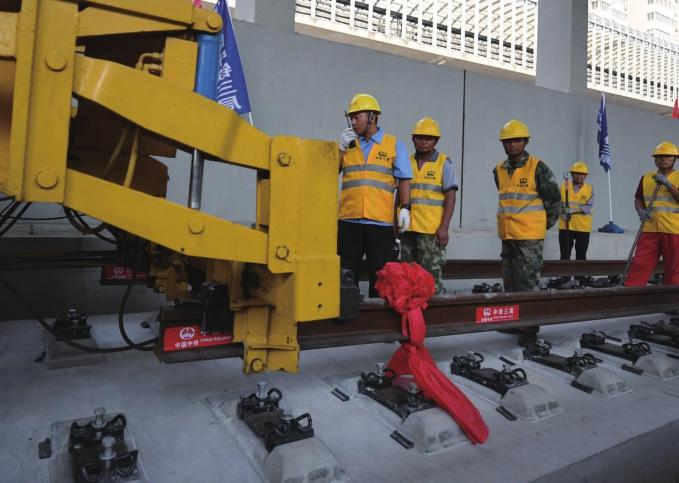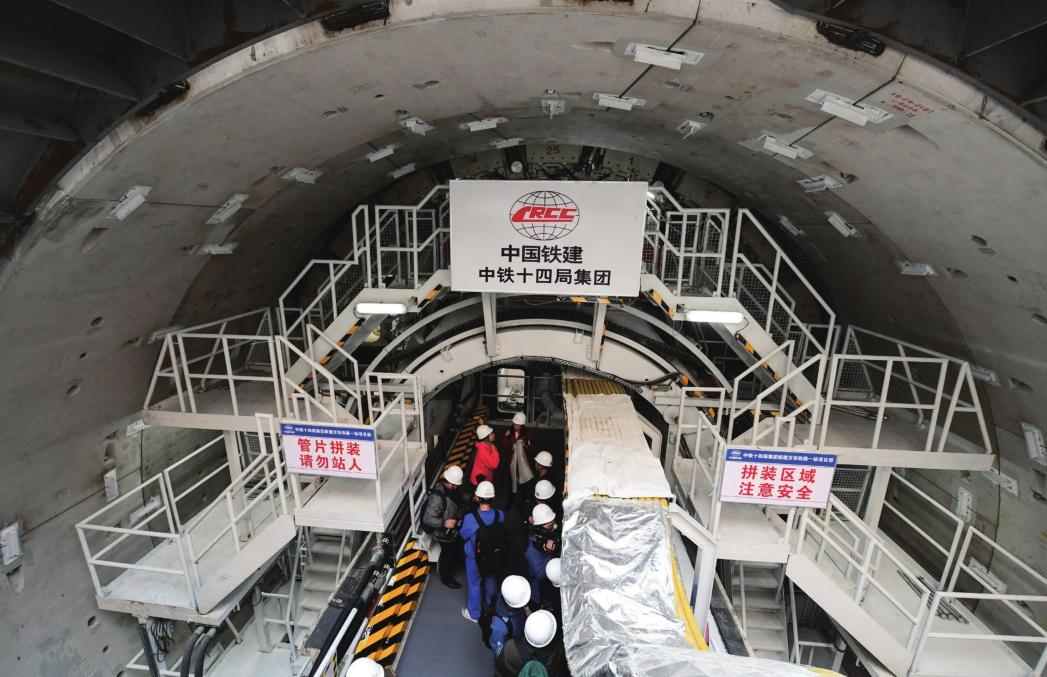On Track
2019-07-09ByWangHairong
By Wang Hairong
Some 110 years after the inauguration of the Beijing-Zhangjiakou Railway—the first railway independently designed and built by Chinese people—a high-speed railway connecting the same two cities is almost ready to roll out.
All track-laying work was fi nished on June 12, and the railway is expected to go into operation at the end of the year.
The high-speed railway will shorten travel time between the venues of the 2022 Winter Olympic Games, which will be co-hosted by Beijing and Zhangjiakou City in neighboring Hebei Province. The ice event venues will be located in downtown Beijing, whereas the snow event venues will be in Yanqing District in northern Beijing and in Zhangjiakou.
With a total length of 174 km, the rail has a designed speed of 350 km per hour, said Sun Chunhui, chief engineer of the railway at China Railway Electrification Engineering Group Co. Ltd. He told the media that it will slash travel time between Beijing and Zhangjiakou to about an hour, from more than three hours by regular train currently.
Hi-tech railway
“The railway not only reflects the economic development and the progress in Chinas modern science and technology, but also shows the unyielding and striving spirit of the Chinese people,” Yang Cunxin, 57, Manager of the Qinglongqiao Station of the Beijing-Zhangjiakou Railway, told the media.
Yang was born in a place close to the station, which is tucked away in the green mountains of Yanqing, at the foot of the Badaling section of the Great Wall. He began to work for the station in 1981 at the age of 19. In the nearly four decades since, Yang witnessed the development of the railway lines passing through the station.
At the Qinglongqiao Station, there is a statue of Zhan Tianyou, chief engineer of the Beijing-Zhangjiakou Railway. The railway was hailed as an engineering feat in China when it was fi rst put into operation in September 1909. Zhan is particularly famous for introducing a zigzag railway design to enable trains, pulled by one locomotive and pushed by another, to scale a relatively steep slope in the vicinity of the station.
Back then, because of numerous bends and steep slopes along the line, trains could only reach a speed of about 35 km per hour.
Today, the Beijing-Zhangjiakou highspeed railway will not only enable trains to travel at incredible speeds, but will also be recorded in history as the first smart highspeed railway in China.
It will be the fi rst in the world where automatic train operation technology is adopted for trains traveling at a speed of 300-350 km per hour, said He Huawu, Vice President of the Chinese Academy of Engineering (CAE), at the opening ceremony of the 2019 World Transport Convention held in Beijing on June 13-16.
He said that the railway, based on big data, is smart in many aspects, including smart construction, logistics, passenger transportation, management, security, maintenance and scheduling.
According to China Railway Beijing Group Co. Ltd., the smart systems are supported by the BeiDou Navigation Satellite System. Sensors will be put into operation along the railway so that real-time “physical exams”can be carried out to detect problems such as aging parts, track subgrade settlement and damaged lights. A perimeter intrusion alarm system, an earthquake warning system and other natural disaster monitoring systems will also be installed for risk prevention and control. Robots will be able to guide passengers and carry their luggage, while passengers will be able to check in via e-tickets or face scanning.
Smart technology has also been used in the construction process, such as in overcoming a technical challenge near the departure station—Beijing North Railway Station. After traveling 270 meters from the starting point, trains have to go into an underground tunnel below Tsinghua University, which presented many issues.
More than 6-km long, the Tsinghua Tunnel is located under a bustling area with many important buildings aboveground and nearly 90 urban pipelines underground, project manager Zhao Haitao told the media in June.
Shield machines were used to excavate the tunnel, so that construction could proceed steadily without damaging any urban facilities or disturbing urban life. A smart system was employed to visualize the tunnel boring process, said Liu Lei, an engineer on the project. Every shield machine was equipped with thousands of sensors, which could automatically transmit data about equipment status and underground conditions to a command center so that shield tunneling experts could remotely monitor the process and provide technical services around the clock, he said.
Another technical problem of a different nature lay in the Donghuayuan Tunnel near Zhangjiakou, adjacent to a big reservoir and a national wetland park. Here, seepage prevention is crucial, so automatic precipitation monitoring and an early warning system were developed.

In addition to smart technology, advanced controlled blasting technology was used during the construction process to minimize environmental damage, said Luo Duhao, another engineer on the railway project. The high-speed railway was designed to pass below the Badaling section of the Great Wall, with the Badaling Station constructed underground. To avoid damage to the Great Wall and the BeijingZhangjiakou Railway, the station is being built at a depth of 102 meters, making it the deepest sitting railway station in the world, Luo said. When explosives were used for tunnel construction, technology was adopted to reduce the vibration caused by blasting, he said.
Development driver
The Beijing-Zhangjiakou high-speed railway will be a new addition to Chinas rapidly expanding network of high-speed railways.
By the end of 2018, the total mileage of Chinas railways was 131,000 km, and that of high-speed railways 29,000 km. In a short span of about a decade, Chinas high-speed railway network has grown dramatically.
China plans to weave a railroad network consisting of “eight vertical and eight horizontal” lines by 2025, with total mileage of 175,000 km, including 38,000 km of highspeed rail, according to the medium- and long-term railway network plan released by the State Council in 2015.
Back in 2008, China planned to construct a railway network of “four vertical and four horizontal” lines by 2020, but that goal was reached in 2015.
The Beijing-Zhangjiakou high-speed railway is located at the eastern section of the line from Beijing to Lanzhou City in north west Chinas Gansu Province. It will speed up transportation between the capital city and areas lying to its northwest, including the northwestern part of Hebei, the western part of Inner Mongolia Autonomous Region and the northern part of Shanxi Province, promoting the integrated development of these areas.
Five years ago, China launched a national strategy promoting the integrated development of the Beijing-Tianjin-Hebei region. Under the strategy, some entities with functions not essential to Beijings role as the nations capital will be moved to neighboring areas to alleviate congestion and pollution in the city.
Under the plan, the northwestern parts of Beijing and Hebei were designated as an ecological conservation area where industrial development is restricted.
With mountains, lakes, reservoirs and grasslands, this region is blessed with rich tourism resources. Thus, the high-speed rail linking Beijing and areas to its northwest is expected to boost tourism and create other development opportunities.
